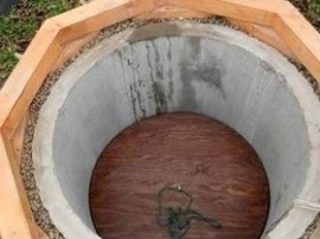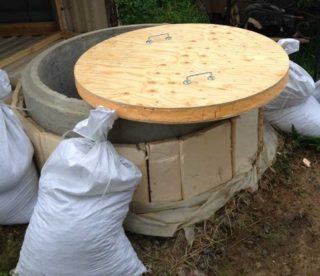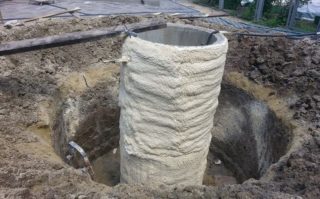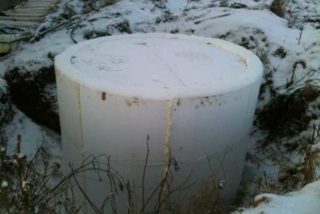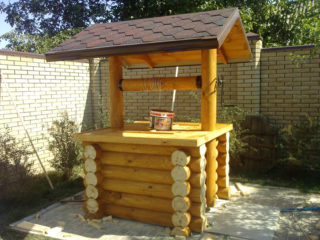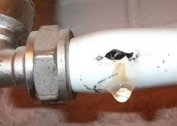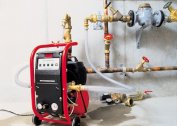Concrete wells must be insulated at the construction stage, regardless of their purpose. Uninsulated plumbing, technical or water wells will freeze, which will lead to damage to equipment, pipelines, and the inability to use communications in severe frosts. In order to effectively perform the insulation of a well from concrete rings, it is necessary to select the appropriate heat-insulating material and observe the technology of its installation.
Functional purpose of wells
Wells of concrete rings are built for different purposes. Due to the specificity of concrete with high thermal conductivity, they freeze at low temperatures. According to the functional purpose, the structures are distinguished:
- For water supply. Necessary where there is no central water supply. In the soil, a depression is made to the aquifer, the casing of the shaft is made with concrete rings.
- Technical In the mine, protected from collapse of the ground with concrete rings, equipment is placed. For example, equip a caisson for a well.
- Plumbing. These include septic tanks made of concrete rings for giving or at home. Rings are also installed in the mine, a drainage layer is poured into the bottom, and sewage is discharged into this pit.
Shallow wells located above the level of soil freezing should be insulated with the highest quality, even if it is a dry technical mine. The service life of equipment operating at low subzero temperatures is reduced. If the equipment or water mirror is below the level of freezing, there is no urgent need for insulation.
Causes of freezing
When central water supply was rare, water wells were made of wood. The thermal conductivity of this material is lower than that of concrete, so they did not freeze even during prolonged frosts. Concrete is characterized by high thermal conductivity, so concrete rings freeze, like the surrounding soil. In addition, wooden houses were often built over the wells, which prevented direct contact of frosty air and water. The difference between water and air temperatures was up to 30 ° C.
Whether an uninsulated mine will freeze also depends on the depth of soil freezing characteristic of the region. In the southern regions, the problem is less relevant, since the freezing depth here is no more than 0.5 m. In temperate latitudes, the soil freezes to a depth of 1.5 m in winter, even deeper in the northern latitudes, so residents of these regions need to take care of high-quality warming.
Do-it-yourself insulation methods
If thermal insulation work has not been carried out at the construction stage, before immediate warming it is necessary to perform a number of preparatory steps: dig a trench around the well with a trench of such a width that it is convenient to mount thermal insulation materials. The depth of the trench should exceed the estimated freezing depth by about 1 m.
Warming of a well from concrete rings is performed in various ways. To avoid large-scale earthworks, sometimes they are limited to the construction of a wooden house located above the mine, the manufacture of a lid or the decoration of the head with heat-insulating material. Underground insulation is most effective, but laborious.
Outdoor ground insulation
External ground insulation includes thermal insulation of the basement (upper concrete ring) and the blind area. When warming the base, it is advisable to go a little deeper into the ground, tearing a trench up to 1 m deep and 30 cm wide.
- The walls are cleaned of soil.
- The base is treated on the outside with coating waterproofing.
- The insulation for the well is cut into strips or a shell of the appropriate diameter is used.
- Glue the base around the perimeter with the help of facade glue, mounting foam.
- Paint the base with oil paint.
- A membrane, film, ruberoid or other materials with water-repellent properties are fixed on top.
- Between the insulation and the walls of the mine fill up drainage - expanded clay, crushed stone, gravel. These materials are also effective as heat insulators.
- On top make a soil layer 25-30 cm thick.
- The lining of the head is carried out with brick, tile, stone, wooden boards.
The blind area is performed to a height of 20 cm by pouring concrete around the well. Frozen concrete is finished with facing materials.
Underground insulation
Underground thermal insulation includes insulation of the entire underground part of the structure. It is especially important to properly insulate a well made of concrete rings for the winter above the level of soil freezing. For a thermal insulation device, you will need:
- insulation;
- polyurethane foam;
- primer for concrete;
- liquid waterproofing;
- polyethylene film;
- wire;
- construction adhesive;
- Decoration Materials.
Perform all the necessary work in stages according to the following scheme:
- They dig a trench with a depth of 0.5 m greater than the depth of freezing of the soil.
- Concrete rings are cleaned of the soil, coated with a primer and waterproofing on the outside.
- Glue the rings with strips of insulation from the bottom up, making sure that the gaps are minimal. For gluing, you can use liquid foam.
- The thermal insulation material should be 10-15 cm higher than the head.
- The joints of the insulation are filled with polyurethane foam.
- Wrap insulation with waterproofing roll. Fix it with wire or nylon cord.
- They fill the trench with drainage: expanded clay mixed with gravel.
- A blind area of 0.5 m wide is made of concrete or clay. Concrete thickness - 20 cm, clay - 40 cm.
- If a house for a well will be installed, fill the foundation.
It is recommended to trim the head with decorative material, install a well house, and insulate the lid.
Thermal insulation
Insulation from the inside is performed for dry wells made of concrete rings, i.e. technical. In a water shaft, internal insulation is reduced to the manufacture of covers that are installed in the barrel. Two covers are made which are fixed at a certain distance from each other. Due to the air congestion, they block cold air and protect against freezing.
Production Order:
- Take plywood with a thickness of 15 mm, cut out of it two circles with a diameter of 3-5 cm less than the inner diameter of the concrete rings.
- The bottom surface is treated with oil paint and covered with a thick plastic film.
- In the lid, make a vent for the diameter of the plastic pipe (up to 5 cm).
- Warm the well cover with polystyrene or polystyrene foam with a thickness of at least 50 mm.
- Two rings are installed on the sides to which a nylon cord is tied.
- Metal staples made of a rod with a thickness of more than 10 mm are embedded in the joint between concrete rings at a level of about 1 m from the water mirror.
- Install the cover on the brackets.
- The cord is fixed.
- A second cover is installed in the same way.
This method is effective, but inconvenient with frequent use of the well, because each time you need to remove the covers to draw water.
The best option is to completely warm the outer part of the well to a depth exceeding the level of freezing of the soil.If you additionally install a wooden house, the well will not freeze even in the most severe and long frosts.
Materials for insulation of wells
The range of thermal insulation materials is represented by heaters with different properties.
Polyurethane foam
Polyurethane foam guarantees a high degree of thermal insulation, is resistant to moisture, is not interesting to insects. The service life is at least 50 years. He has only two drawbacks: complex application technology and high cost. Available in the form of a liquid composition in cylinders and as a mixture, which must be diluted before application, according to the manufacturer's instructions. For work, spray equipment is required. The coating fills all the cracks and grooves; no joints are formed that could serve as cold bridges. Before applying polyurethane foam, the concrete surface should be treated with a primer, and the surface of the well after the completion of work should be coated with paint for outdoor use. In air, the coating of polyurethane foam sets in a few minutes, completely hardens in 4-5 hours.
Polyurethane foam can only be applied in the temperature range from +15 to + 30 ° C.
Expanded polystyrene
By its properties, polystyrene foam resembles polystyrene foam, but its thermal conductivity is lower and its resistance to loads is higher. In addition, it does not deform under the influence of the soil layer, is resistant to mold and corrosion, and has been used for more than 25 years. Expanded polystyrene of domestic production Penopleks, URSA, Technoplex, Tenziplex will cost less than a similar imported insulation, but it is 20-30% more expensive than polystyrene. The joints of the insulation must be blown with foam and wrap the installed insulation with rolled waterproofing.
To warm the well, it is recommended to use slabs with a width of 30 cm. They can be denser laid in a circle. If the outer part is insulated, staples are used for more durable fastening of the insulation.
Styrofoam
Polyfoam can be used to warm a well both at the construction stage and after. This material shows a high resistance to deformation, a low degree of water absorption. At the cost of foam, the most affordable of all heat-insulating materials, it is easy to install. However, poor-quality insulation at high temperatures emits styrenes - toxic substances that poison the environment. Another drawback is that insects and rodents are not indifferent to the foam.
Foam insulation is available in the form of a shell, which is ideal for warming concrete wells, since its diameter coincides with the rings of the most popular sizes.
Installation instructions:
- The walls of the well are cleaned of debris and soil.
- The insulation is mounted on the facade glue, if necessary, strengthening it with a dowel-nails.
- Perform vapor barrier.
- Bury the trench.
Wood
An array of wood is used to warm the outer part of the well. An independent method is the construction of a log house, which is installed like a house. A well gate can be secured between the walls.
Mineral wool is not used for warming concrete wells, which is explained by its low water-repellent properties. Gathering moisture, the material ceases to work as a heat insulator. You can use natural materials: expanded clay, linen tow, straw.
Well cover and pipe insulation
Thermal insulation of the cover increases the overall effectiveness of frost protection. It is recommended to make a wooden lid for a well from plywood or tightly fitted wooden boards. It is made of two layers of material with a thickness of at least 18 mm, a heater is laid between them. It is best to use polystyrene and polystyrene foam for this purpose. Reinforced concrete cover also needs to be insulated.The heat insulator is fixed with dowels and nails on concrete or with glue for outdoor use.
It is necessary to take care of the insulation of the water pipe for supply, sewer pipe, the place of entry of the pipe into the house. For this purpose, use the shell of the PPU, a heating cable.
Warming of a well made of reinforced concrete rings must be performed even when using it in the warm season. When freezing, the water expands, due to which concrete rings move, diverge or crack. Also, when freezing hoses, pipes are destroyed, the service life of the equipment is reduced. Thanks to a wide range of heat-insulating materials, it is possible to choose a heater that is suitable in terms of properties and price.

